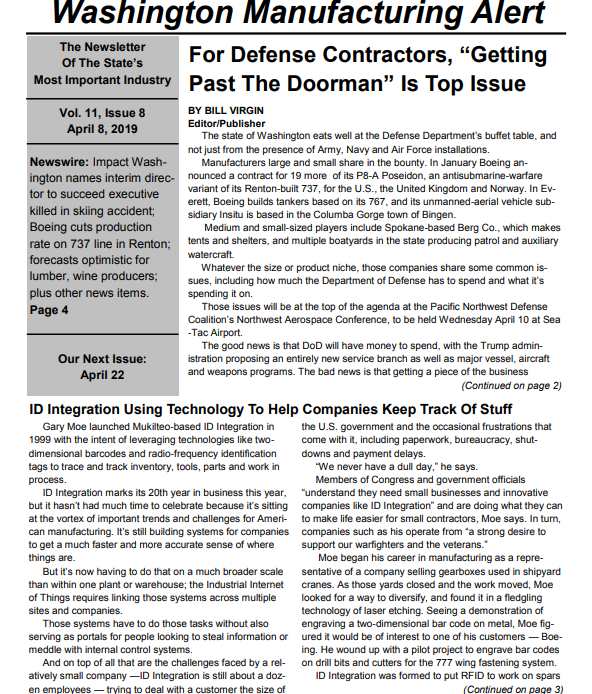Reprinted with permission from the Washington Manufacturing Alert
Vol. 11, Issue 8, Published on April 8, 2019
Gary Moe launched Mukilteo-based ID Integration in 1999 with the intent of leveraging technologies like two-dimensional barcodes and radio-frequency identification tags to trace and track inventory, tools, parts and work in process.
ID Integration marks its 20th year in business this year, but it hasn’t had much time to celebrate because it’s sitting at the vortex of important trends and challenges for Ameri-can manufacturing. It’s still building systems for companies to get a much faster and more accurate sense of where things are.
But it’s now having to do that on a much broader scale than within one plant or warehouse; the Industrial Internet of Things requires linking those systems across multiple sites and companies.
Those systems have to do those tasks without also serving as portals for people looking to steal information or meddle with internal control systems.
And on top of all that are the challenges faced by a relatively small company —ID Integration is still about a dozen employees — trying to deal with a customer the size of the U.S. government and the occasional frustrations that come with it, including paperwork, bureaucracy, shut-downs and payment delays.
“We never have a dull day,” he says.
Members of Congress and government officials “understand they need small businesses and innovative companies like ID Integration” and are doing what they can to make life easier for small contractors, Moe says. In turn, companies such as his operate from “a strong desire to support our warfighters and the veterans.”

Moe began his career in manufacturing as a representative of a company selling gearboxes used in shipyard cranes. As those yards closed and the work moved, Moe looked for a way to diversify and found it in a fledgling technology of laser etching. Seeing a demonstration of engraving a two-dimensional bar code on metal, Moe figured it would be of interest to one of his customers — Boeing. He wound up with a pilot project to engrave bar codes on drill bits and cutters for the 777 wing fastening system.
ID Integration was formed to put RFID to work on spars at Boeing’s Frederickson plant in 1999. Tracking and tracing technology got further momentum as both Boeing and Airbus required suppliers to put bar codes on flyable air-plane parts to compile lists of serial numbers for their air-line customers.
While 9/11 halted, for a time, development programs in commercial aviation, ID Integration got involved in the Chinook helicopter program, which had a problem with bad parts but couldn’t identify which ones had them.
Diversification is still a goal for ID Integration. “We’re always looking to do more commercial work,” Moe says. The company’s revenues are currently split about evenly between military and commercial, although Moe says some of the commercial work is for original-equipment manufacturers fulfilling defense contracts.
Moe sees growth coming from manufacturing operations and business sectors outside aerospace and the military, such as medical devices and health care.
What customers, and ID Integration, are after are ways to reduce human involvement in data entry. In the original Boeing project, for example, workers had to read paper drawings and match the information there to what was on on the tooling. The barcode system eliminated the problem of grabbing the wrong tool and allowed the company to reduce tooling inventory. Handheld scanners eliminate the need to manually enter serial or parts numbers.
“It was more about eliminating mistakes and errors and having better visibility in asset tracking,” Moe says.
“Counterfeiting and cybersecurity have come to the fore in the last five years.”
Two-dimension bar codes have gotten sophisticated enough to contain information that, once introduced to a company’s computer system, can disable a firewall. ID Integration now offers scanners with built-in filters to detect and block such threats.
Moe is optimistic about prospects — “every year the technology gets better, faster, cheaper” — but he’s also realistic about how fast the future will arrive. “Part of our challenge is that it’s not always about the technology, It’s hard to change processes and to train people. You need a commitment from senior leadership.”
He’s also careful not to oversell what the technology can do. “We’ve had to learn to say no,” in cases where expectations ran ahead of reality. “You can’t change the physics of RFID,” and customers expecting a system to grab information from objects anywhere on the shop floor or in the warehouse may be disappointed.
